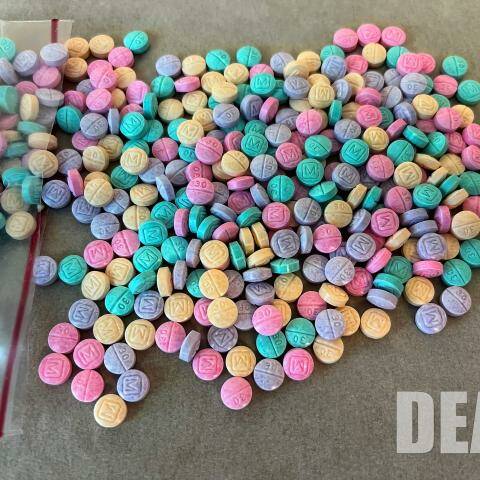An epidemic of fentanyl overdoses has been raging across North America for years. The waves of that epidemic are lapping at the shores of San Juan County.
“There have been three [fentany overdose] deaths in this county since the beginning of COVID. All of them young people. In that same period of time, in every age group, three people died of COVID.” local pediatrician Dr. Mark Fishaut told attendees of the family dinner held at Friday Harbor High School cafeteria May 11. The event was sponsored by the Joyce Sobel Family Resource Center. Presenters included Fishaut, Deputy Issac Norton, Melanie Kaegi, Juvenile Probation Counselor for San Juan County and Linnea Anderson, Superior Court Services Administrator, as well as EMT Ryder Cuddington. The goal was to educate and increase awareness in youth and families about fentanyl.
The mostly teen audience peppered presenters with questions. One student, for example, asked if fentanyl was more fatal for young people. Since teens and children tend to have a smaller body frame, it does not take as much to cause an overdose, Fishaut responded. Even for adults, it does not take much to lull the body into stopping breathing.
For Fishaut, not only is the issue real but personal. He knew and treated those young islanders throughout their childhood.
Fishaut began the presentation with some basics.
“Fentanyl is an opiate, like morphine, heroin, codeine and in small doses, is a useful drug,” Fishaut explained, “It allows some procedures to be done in a less painful manner.”
Fentanyl is powerful, however, 100 times stronger than heroin and can stop breathing in minutes.
According to Norton, fentanyl is quickly taking over as the primary choice of drug in the county. Methamphetamine, Xanax, heroin, cocaine, and magic mushrooms are some of the other common illicit drugs the Sheriff’s Office has found.
Norton also explained to the youths that they can not be arrested for attempting to assist a person having a drug overdose. In fact, RCW 69.50.315 states that a person acting in good faith who seeks medical attention for someone experiencing a drug overdose will not be arrested.
Anderson and Kaegi came with prepared activities centered around safety and urged attendings to think about where to turn in times of crisis before a crisis occurs. Their questions for the audience ranged from where and with whom do you feel the most safe. Students wrote down the answers to the questions on a sticky note and put them up on a board.
The questions and results were as follows:
The Community: If you are experiencing a dangerous or risky situation what person, place or agency can you seek safety and help?
85% reported seeking help from family or friends.
15% reported a place or agency where they could/would seek help.
School: Schools are known to be safe and supportive, is this true for you? If true, who helps create this supportive place?
92% reported the school is a safe and supportive environment- lots of positive responses about teachers and staff.
8% reported school is not safe or supportive.
Household: Are there safe people in your household, that you can seek help and support? If yes, who are they?
95% reported at least one person in their household is safe and supportive- lots of reports of safe parents, aunts, cousins, siblings and pets.
5% reported no safe household members.
Peers: Of your top five closest peers, how many are safe and how many are risky?
52% reported no risky peers in their top five.
48% reported risky peers in their top five.
6% reported 3 or more risky peers in their top five.
In the email containing feedback from teens, Anderson wrote that she was amazed by the participation. ” I deeply appreciated the youth were willing to share their experiences and knowledge. Thank you all again for creating this community learning environment!”
Cuddington started his presentation by asking attendees to reflect on breathing.
“Your body knows what to do, you don’t have to tell it to breathe. Opiates block the receptors that make you breathe,” Cuddington explained. Narcan’s molecules are shaped like an opiate, which can unblock the receptors causing the person to breathe again.
It can be administered in two ways, through the nose in a spray, or a shot.
Once Narcan is administered, the individual should begin breathing. If they do not, Cuddington said, begin CPR.
One student asked if Narcan would take the person’s high away.
“It will take the high away, they are going to feel everything,” Cuddington explained.
“This will probably be the most intense thing you ever do, but you will save someone’s life,” Cuddington said, adding that as previous presenters noted, fentanyl is everywhere now, and someone could accidentally ingest some leading to an overdose.
Narcan is not harmful, should it turn out the individual didn’t overdose, and in Washington State it is free for anyone who would like to have it on hand.
“The scariest thing is knowing your friend has a problem. Knowing someone is hurt makes it easy because your adrenaline starts pumping. When no one is hurt you overthink [the situation],” Cuddington said.
To order Narcan go to https://docs.google.com/forms/d/e/1FAIpQLSd4Wut2Ai5SANt3ZAHj7WOC5KynstN9vcfzIXYIp9bNg6iVyw/viewform
To view a video on how to administer Narcan, visit https://www.ama-assn.org/delivering-care/overdose-epidemic/how-administer-naloxone



